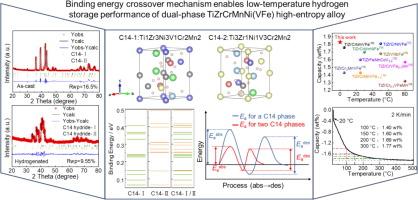Binding energy crossover mechanism enables low-temperature hydrogen storage performance of dual-phase TiZrCrMnNi(VFe) high-entropy alloy
IF 13.3
1区 工程技术
Q1 ENGINEERING, CHEMICAL
引用次数: 0
Abstract
High-entropy hydrogen storage alloys possess immense potential for composition-performance modulation, yet they currently struggle to strike a balance between high capacity, stability, and low-temperature dehydrogenation. In this work, a novel TiZrCrMnNi(VFe) high-entropy alloy (HEA) was designed and dual-phase synergistic effect during the de-/hydrogenation processes was proposed. Specifically, the as-synthesized TiZrCrMnNi(VFe) alloy comprises two approximate C14 Laves phases, denoted as C14-Ⅰ and C14-Ⅱ phases. A noteworthy feature is that TiZrCrMnNi(VFe) HEA can rapidly reach a saturated capacity of 1.83 wt% H2 at 0 °C without any activation treatment, and then desorb 1.77 wt% H2 with a low onset dehydrogenation temperature of 20 °C. Based on experimental evidence and DFT calculations, it is concluded that dual-phase structure offers a distinguished phenomenon of binding energy crossover. Accordingly, compared with a single C14 phase, the structure with two C14 phases produces dual-phase synergistic effect, facilitating the de-/hydrogenation processes by lowering the energy barrier. In addition, the existence of phase boundaries also improves the activation performance of the alloy. Consequently, TiZrCrMnNi(VFe) HEA has excellent activation and low-temperature de-/hydrogenation performance. The innovative outcomes here provide a valuable reference for subsequent research on the low temperature de-/hydrogenation of HEAs

结合能交叉机制实现了双相 TiZrCrMnNi(VFe)高熵合金的低温储氢性能
高熵储氢合金在成分-性能调控方面具有巨大潜力,但目前还难以在高容量、稳定性和低温脱氢之间取得平衡。本研究设计了一种新型 TiZrCrMnNi(VFe)高熵合金(HEA),并提出了在脱氢/加氢过程中的双相协同效应。具体来说,合成的 TiZrCrMnNi(VFe)合金由两个近似的 C14 Laves 相组成,分别称为 C14-Ⅰ 和 C14-Ⅱ 相。一个值得注意的特点是,TiZrCrMnNi(VFe) HEA 无需任何活化处理即可在 0 °C 时迅速达到 1.83 wt% H2 的饱和容量,然后在 20 °C 的低起始脱氢温度下脱附 1.77 wt% H2。根据实验证据和 DFT 计算得出的结论是,双相结构具有独特的结合能交叉现象。因此,与单个 C14 相相比,具有两个 C14 相的结构会产生双相协同效应,通过降低能垒促进脱氢/加氢过程。此外,相界的存在也提高了合金的活化性能。因此,TiZrCrMnNi(VFe) HEA 具有优异的活化和低温脱氢/加氢性能。这些创新成果为后续的 HEA 低温脱氢/烃化研究提供了宝贵的参考。
本文章由计算机程序翻译,如有差异,请以英文原文为准。
求助全文
约1分钟内获得全文
求助全文
来源期刊

Chemical Engineering Journal
工程技术-工程:化工
CiteScore
21.70
自引率
9.30%
发文量
6781
审稿时长
2.4 months
期刊介绍:
The Chemical Engineering Journal is an international research journal that invites contributions of original and novel fundamental research. It aims to provide an international platform for presenting original fundamental research, interpretative reviews, and discussions on new developments in chemical engineering. The journal welcomes papers that describe novel theory and its practical application, as well as those that demonstrate the transfer of techniques from other disciplines. It also welcomes reports on carefully conducted experimental work that is soundly interpreted. The main focus of the journal is on original and rigorous research results that have broad significance. The Catalysis section within the Chemical Engineering Journal focuses specifically on Experimental and Theoretical studies in the fields of heterogeneous catalysis, molecular catalysis, and biocatalysis. These studies have industrial impact on various sectors such as chemicals, energy, materials, foods, healthcare, and environmental protection.
 求助内容:
求助内容: 应助结果提醒方式:
应助结果提醒方式:


